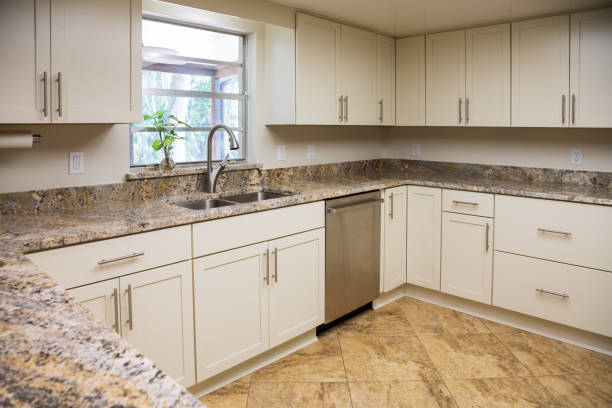Touchless kitchen faucets have become increasingly popular in recent years due to their convenience and hygienic benefits. These faucets use motion sensors to detect when hands are placed under the faucet, allowing water to flow without the need to touch any handles or knobs. This touchless technology has been used in public restrooms for years but is now becoming a common feature in modern kitchens.
Page Contents
The Pros of Touchless Kitchen Faucets
Enhanced Hygiene:
One of the most significant advantages of touchless kitchen faucets is improved hygiene. Traditional faucets require you to turn handles with potentially dirty hands, spreading germs in the process. Touchless faucets eliminate this problem by using motion sensors to start and stop the flow of water, reducing the risk of cross-contamination.
Water Conservation:
Touchless faucets are equipped with sensors that precisely control water flow. This leads to reduced water wastage, as the faucet only runs when it detects your hands or objects under it. Over time, this can translate into significant water savings and lower utility bills.
Convenience:
Imagine having your hands full with raw chicken while cooking and needing to turn on the tap. Touchless faucets allow you to start the water flow with a simple hand wave, making kitchen tasks more convenient and less messy.
Ease of Cleaning:
The absence of handles and knobs makes touchless faucets easier to clean and maintain. There are fewer crevices for grime and bacteria to accumulate, simplifying the cleaning process.
Modern Aesthetics:
Touchless faucets come in sleek and contemporary designs, instantly giving your kitchen a modern and sophisticated look. They are available in various finishes to match your kitchen’s decor.
Longevity:
Touchless faucets are often built with durable materials and advanced technology, which can contribute to their longevity. Many models also come with extended warranties, giving you peace of mind.
Energy Efficiency:
Some touchless faucets have energy-saving features, like automatic shut-off after a certain period of inactivity. This not only conserves water but also reduces energy consumption.
The Cons of Touchless Kitchen Faucets
Initial Cost:
Touchless kitchen faucets tend to be more expensive upfront compared to traditional faucets. However, this cost can often be justified by the long-term benefits they provide.
Installation Complexity:
Installing a touchless faucet may be more complicated than installing a standard faucet. It often requires electrical connections for the sensor, which could mean additional installation costs if you need to hire a professional plumber.
Dependency on Power:
Touchless faucets require a power source to operate the sensors. This can be a drawback during power outages, as the faucet may not function unless it has a battery backup or alternative power source.
Sensor Sensitivity:
Some users may find that touchless faucet sensors can be overly sensitive, leading to unintentional activation when you’re near the sink but not intending to use the faucet.
Learning Curve:
Adjusting to a touchless faucet may take some time, especially for those accustomed to traditional faucets. Users may need to get used to the sensor’s range and responsiveness.
Maintenance:
While touchless faucets are generally easier to clean, they may require occasional maintenance to ensure the sensors remain functional. This can include cleaning the sensor’s surface and replacing batteries if applicable.
Limited Options:
The market for touchless kitchen faucets is not as extensive as that for traditional faucets, limiting your choices in terms of design and style.
What should I look for in a touchless faucet?
When looking for a touchless kitchen faucet, you should consider the following features:
- Flow rate: The flow rate of a touchless kitchen faucet is measured in gallons per minute (GPM). The average flow rate for a kitchen faucet is 2.2 GPM. However, some touchless faucets have a lower flow rate to conserve water.
- Spout height: The height of the spout is important because it determines how much clearance you have between the faucet and the sink. A higher spout will give you more clearance for washing larger pots and pans.
- Finish: Touchless kitchen faucets come in a variety of finishes, including chrome, stainless steel, brushed nickel, and oil-rubbed bronze. Choose a finish that complements your kitchen decor.
- Sensor range: The sensor range determines how far away your hand can be from the faucet before it turns on. A longer sensor range is better because it gives you more flexibility when using the faucet.
- Power source: All touchless kitchen faucets require a power source. Some are battery-powered, while others require an electrical outlet. Battery-powered faucets are more convenient because they don’t require an electrical outlet
Conclusion
So, are touchless kitchen faucets worth it? The answer largely depends on your priorities and budget. If you value enhanced hygiene, water conservation, and modern convenience, a touchless kitchen faucet could be a worthwhile investment. However, you should be prepared for the initial cost and potential installation complexities.
On the other hand, if you prefer a simpler and more budget-friendly option, traditional faucets may be a better choice for you. Ultimately, the decision should align with your kitchen needs, lifestyle, and your willingness to embrace the modern technology that touchless faucets bring to your culinary space.

Lois Lane is a professional blogger and a seasoned Content writer for wellhousekeeping.com. With a passion for simplifying complex Home Decor topics, he provides valuable insights to a diverse online audience. With four years of experience, Lois has polished his skills as a professional blogger.




